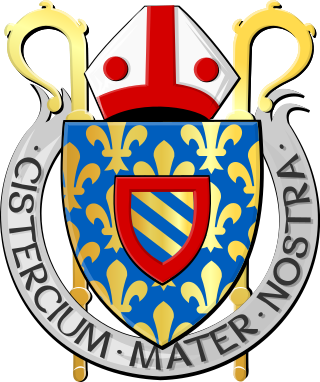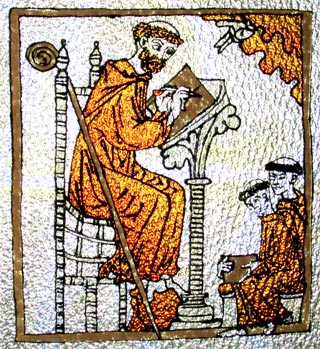Related Research Articles

Cîteaux Abbey is a Catholic abbey located in Saint-Nicolas-lès-Cîteaux, south of Dijon, France. It is notable for being the original house of the Order of Cistercians. Today, it belongs to the Trappists.

The Cistercians, officially the Order of Cistercians, are a Catholic religious order of monks and nuns that branched off from the Benedictines and follow the Rule of Saint Benedict, as well as the contributions of the highly-influential Bernard of Clairvaux, known as the Latin Rule. They are also known as Bernardines, after Saint Bernard himself, or as White Monks, in reference to the colour of the "cuculla" or cowl worn by the Cistercians over their habits, as opposed to the black cowl worn by Benedictines.

Trappist beer is brewed by Trappist monks. Thirteen Trappist monasteries—six in Belgium, two in the Netherlands, and one each in Austria, Italy, England, France, and Spain— produce beer, but the Authentic Trappist Product label is assigned by the International Trappist Association (ITA) to just ten breweries that meet their strict criteria. As of 2021, Achel is no longer recognized as a Trappist brewery because it does not have any monks.

The Trappists, officially known as the Order of Cistercians of the Strict Observance and originally named the Order of Reformed Cistercians of Our Lady of La Trappe, are a Catholic religious order of cloistered monastics that branched off from the Cistercians. They follow the Rule of Saint Benedict and have communities of both monks and nuns that are known as Trappists and Trappistines, respectively. They are named after La Trappe Abbey, the monastery from which the movement and religious order originated. The movement first began with the reforms that Abbot Armand Jean le Bouthillier de Rancé introduced in 1664, later leading to the creation of Trappist congregations, and eventually the formal constitution as a separate religious order in 1892.

The Abbey of Our Lady of Gethsemani is a Catholic monastery in the United States near Bardstown, Kentucky, in Nelson County. The abbey is part of the Order of Cistercians of the Strict Observance, better known as the Trappists. Founded on December 21, 1848, and raised to an abbey in 1851, Gethsemani is considered to be the motherhouse of all Trappist and Trappistine monasteries in the United States. Gethsemani is the oldest Trappist monastery in the country that is still operating.
Adam of Perseigne was a French Cistercian, abbot of Perseigne Abbey in the Diocese of Le Mans.

An antiphonary or antiphonal is one of the liturgical books intended for use in choro, and originally characterized, as its name implies, by the assignment to it principally of the antiphons used in various parts of the Latin liturgical rites.

Cistercian nuns are female members of the Cistercian Order, a religious order belonging to the Roman Catholic branch of the Catholic Church.
Westmalle Abbey, otherwise the Trappist Abbey of Westmalle, is a monastery of the Cistercians of Strict Observance in Westmalle in the Belgian province of Antwerp.

La Trappe Abbey, also known as La Grande Trappe, is a monastery in Soligny-la-Trappe, Orne, France. It is known for being the house of origin of the Trappists, to whom it gave its name.

Vaux-de-Cernay Abbey is a former Cistercian monastery in northern France (Île-de-France), situated in Cernay-la-Ville, in the Diocese of Versailles, Yvelines. The abbey was abandoned during the French Revolution and fell into partial ruin. Most of the buildings, except for the church, were restored in the late 19th century by Charlotte de Rothschild, and the property is now a hotel.
Augustin de Lestrange was a French Trappist abbot, an exile from France after the French Revolution.

Melleray Abbey was a Cistercian monastery, founded about the year 1134. It was situated in La Meilleraye-de-Bretagne in the vicinity of Châteaubriant in Brittany, in the present Loire-Atlantique, France, and in the Diocese of Nantes. Between 1817 and 2016 it was a house of Trappist monks. Since 2016 it has been used by the Chemin Neuf Community.

Soleilmont Abbey is an abbey of Trappistine nuns situated in the forest and commune of Fleurus, at Gilly near Charleroi, Belgium, founded, according to tradition, in the 11th century, which became Cistercian in 1237. The nuns were expelled as a consequence of the French Revolution in 1796, but soon re-established themselves in 1802. The community became Bernardine in 1837, and Trappist in 1919.

Igny Abbey or Val d'Igny Abbey is a Cistercian abbey located in Arcis-le-Ponsart, Marne, France. It was founded in 1128 for Cistercian monks, dissolved in 1791 during the French Revolution, re-established in 1876 for Trappist monks, destroyed in 1918, reopened in 1929 for Trappist nuns and modernised in 2008–12 to accommodate three or four pre-existing communities.

Guerric of Igny was a Cistercian abbot. Little is known about his early life. He may have been educated at Tournai's cathedral school, perhaps under Benedictine monk, Odo of Cambrai. Guerric appears to have lived a life of prayer and study near the Tournai Cathedral. His monastic formation was directly influenced by Bernard of Clairvaux, who praises him in several letters. In 1138, he became abbot of Igny Abbey, in the diocese of Rheims, a house dependent on Clairvaux. Here Guerric ruled as abbot until his death on 19 August 1157. It was here that he composed the 54 liturgical sermons that constitute his surviving works.

Mariastern Abbey is a Trappist abbey in Bosnia and Herzegovina, situated near the country's second largest city Banja Luka. It consists of the Church of the Assumption of the Blessed Virgin Mary and the monastery of Trappist monks. It is the only Trappist monastery in Southeastern Europe. At the beginning of the 20th century, with 219 monks, the Abbey was the largest Trappist abbey in the world; today it is the smallest, with only two monks.
Conrad of Eberbach was a Cistercian monk, and later abbot, of Eberbach Abbey, Germany, and historian of the early Cistercian Order.
Dom Joseph-Marie, born Ovide Ernest Ursmer Ghislain Canivez (1878–1952), was a Belgian historian of the Cistercian order and a monk of Scourmont Abbey.
References
- ↑ Archdale Arthur King: Cîteaux and Her Elder Daughters (London: Burns & Oates, 1954), p. 101.
- ↑ La Terre et la vie, Société national de protection de la nature et d'acclimatation de France, 1885, vol. 32 (1885), p. xlvii.
- ↑ Konrad Eubel, Hierarchia Catholica vol. 8, p. 223.
- ↑ Compendium of the history of the Cistercian order. (Trappist, Kentucky: 1944), p. 292.